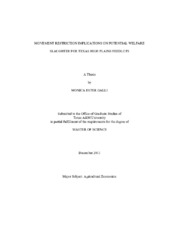| dc.description.abstract | Foot and mouth disease (FMD) is regarded as one of the greatest biological threats to the U.S. livestock industry because of its potential to cause catastrophic economic damages and massive livestock depopulation. Current U.S. contingency plans call for "stamping out" of FMD. An integral component of a "stamping out" policy is movement restrictions. The main purpose for movement restrictions is to stop the spread of disease, but they also disrupt the agribusiness sector. Welfare slaughter, the depopulation of healthy quarantined animals, is a possibility if movement restrictions are kept in place for prolonged periods of time. Many studies have analyzed the economic consequences of alternative mitigation strategies, but generally these studies have ignored the costs that might arise because of movement restrictions affecting uninfected premises located within the quarantine zone. Ultimately this study seeks to improve preparedness in the event of a FMD outbreak. It does this by developing information for those formulating plans on the costs associated with movement restrictions regarding quarantined, uninfected large feedlots located in the Texas High Plains Region.
To accomplish this objective two strategies were compared: an unrestricted feed strategy, where feed is allowed to be brought onto uninfected premises and finished cattle are sold; and a welfare slaughter strategy, where feed isn't allowed to be brought onto the uninfected premises so animals are depopulated. In addition, seasonal differences in total costs were examined. This study expanded on the High Plains Study conducted by M. Ward, L. Highfield, P. Vongseng, and M. Garner by using their epidemiological data combined with a cost accounting framework to estimate the total cost of each strategy. This study examined direct disease management costs (indemnity payments, feed costs, marketing costs, surveillance costs, cleaning and disinfecting costs, appraisal cost, euthanasia costs, and disposal costs). Overall, the unrestricted feed strategy was less expensive than the welfare slaughter strategy, costing on average $22.6 million compared to $48.5 million, respectively. Disease outbreak timing did impact the overall cost of both strategies. The results suggest the policy makers should strongly consider creating movement policies that address feed supply and finished cattle movement for uninfected large feedlots in prolonged quarantine zones; as such policies appear to reduce outbreak related costs for stakeholder and the U.S. government. | en |


